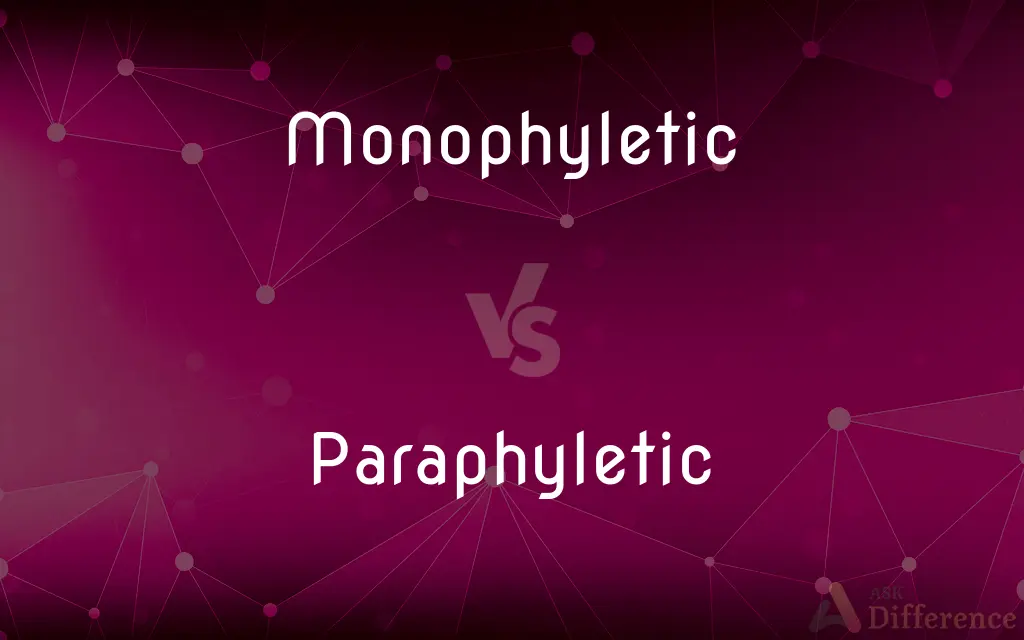Monophyletic vs. Paraphyletic — What's the Difference?
By Fiza Rafique & Maham Liaqat — Updated on February 22, 2024
Monophyletic groups consist of an ancestor and all its descendants, showcasing a complete branch of the evolutionary tree. Paraphyletic groups include an ancestor and some, but not all, of its descendants, omitting at least one lineage.

Difference Between Monophyletic and Paraphyletic
Table of Contents
ADVERTISEMENT
Key Differences
Monophyletic and paraphyletic are terms used in phylogenetics to describe the relationships and evolutionary history of organisms within groups called clades. Paraphyletic groups, on the other hand, are somewhat artificial in the context of evolutionary relationships because they include an ancestor and only some of its descendants, excluding one or more groups that also share the same ancestor.
A monophyletic group, also known as a clade, represents a "true" group in evolutionary terms, containing an ancestor and all of its descendants. For example, all birds and their common ancestors form a monophyletic group, highlighting their evolutionary journey from their earliest ancestor. A classic example of a paraphyletic group is reptiles. When defined traditionally (excluding birds), reptiles do not form a complete clade since birds also descend from the same ancestors as crocodiles and other reptiles.
The distinction between monophyletic and paraphyletic groups is crucial for understanding evolutionary relationships accurately. Monophyletic groups are universally accepted in modern taxonomy and phylogenetics because they reflect true evolutionary histories. In contrast, paraphyletic groups, while useful in some contexts for discussing certain traits or evolutionary stages, can lead to misunderstandings about the actual evolutionary relationships among organisms.
Identifying whether a group is monophyletic or paraphyletic involves examining the evolutionary tree, or phylogeny, of the organisms in question. This examination helps scientists understand how species evolved and how they are related to one another, guiding research in evolution, genetics, and conservation efforts.
Comparison Chart
Definition
Includes an ancestor and all of its descendants.
Includes an ancestor and some, but not all, of its descendants.
ADVERTISEMENT
Also Known As
Clade
N/A
Represents
A complete branch of the evolutionary tree.
An incomplete branch of the evolutionary tree.
Example
Birds (Aves) are a monophyletic group, including all descendants of their common ancestor.
Reptiles (excluding birds) are a paraphyletic group because they exclude birds, which share a common ancestor.
Taxonomic Acceptance
Preferred in modern taxonomy and phylogenetics.
Less preferred due to incomplete representation of evolutionary relationships.
Utility
Reflects true evolutionary histories and relationships.
Useful for discussing traits or stages within evolution, despite not showing complete lineages.
Identification
Based on the presence of shared derived characteristics from a common ancestor.
Based on the exclusion of one or more descendant groups from an ancestral group.
Compare with Definitions
Monophyletic
Ancestor and all its descendants.
The mammalian class is monophyletic, encompassing all mammals and their common ancestor.
Paraphyletic
Ancestor and some descendants.
Reptiles, excluding birds, form a paraphyletic group.
Monophyletic
Reflects complete evolutionary paths.
The group of angiosperms (flowering plants) is monophyletic.
Paraphyletic
Excludes at least one lineage.
The class Amphibia is paraphyletic if it excludes some descendants that have evolved into reptiles.
Monophyletic
Supports accurate phylogenetic relationships.
Phylogenetic trees of vertebrates highlight monophyletic groups based on vertebral characteristics.
Paraphyletic
Useful for discussing evolutionary stages.
Paraphyletic groups can illustrate how fishes gave rise to land vertebrates.
Monophyletic
Identified by shared derived traits.
Monophyletic groups are identified through traits that appear in the ancestor and all its descendants.
Paraphyletic
Less preferred in modern taxonomy.
The concept of fish is paraphyletic because it excludes tetrapods, despite their common ancestry.
Monophyletic
Basis for modern classification.
The bird class, Aves, is classified as a monophyletic group based on genetic evidence.
Paraphyletic
Can lead to misunderstandings in evolutionary relationships.
Considering dinosaurs (excluding birds) as a separate group is paraphyletic and overlooks the evolutionary link to birds.
Monophyletic
Of or relating to a group of taxa that includes the common ancestor of all the members as well as all descendants of that ancestor.
Paraphyletic
Of or relating to a group of taxa that includes the common ancestor of all the members but not all descendants of that ancestor.
Monophyletic
(biology) Descending from a single ancestral species.
Paraphyletic
(systematics) Of a defined group of taxa, not including all descendants of the most recent common ancestor of all members.
Monophyletic
Descending from a single ancestral species but not containing all descendants of that ancestor, paraphyletic.
Monophyletic
(biology) Of, pertaining to, or affecting a single phylum (or other taxon) of organisms.
Monophyletic
Of or pertaining to a single family or stock, or to development from a single common parent form; - opposed to polyphyletic; as, monophyletic origin.
Common Curiosities
How do scientists determine if a group is monophyletic?
By analyzing genetic data, fossil records, and morphological characteristics to trace shared derived traits from a common ancestor.
What impact does recognizing a group as paraphyletic have on conservation?
Recognizing a group as paraphyletic may affect conservation priorities by potentially overlooking evolutionary connections that highlight the ecological importance of certain species.
Can a group be both monophyletic and paraphyletic?
No, a group cannot be both; it's either monophyletic (includes an ancestor and all its descendants) or paraphyletic (excludes some descendants).
What defines a paraphyletic group?
A paraphyletic group includes a common ancestor and some, but not all, of its descendants.
Why are monophyletic groups preferred in taxonomy?
They accurately reflect evolutionary relationships by including all descendants of a common ancestor, facilitating a clearer understanding of biodiversity.
Why might paraphyletic groups still be used?
They can be useful for discussing certain evolutionary traits or stages, even though they don't accurately represent evolutionary relationships.
What does monophyletic mean?
Monophyletic refers to a group of organisms that consists of all the descendants of a common ancestor, including that ancestor itself.
Why is the concept of monophyly important in evolutionary biology?
Monophyly helps scientists accurately represent evolutionary relationships and understand how traits and genes have evolved over time.
How can you distinguish between monophyletic and paraphyletic groups?
Monophyletic groups include all descendants of a common ancestor, whereas paraphyletic groups exclude one or more descendants.
What is an example of a monophyletic group?
Birds (Aves) are an example of a monophyletic group, as they include all descendants from their most recent common ancestor.
What is an example of a paraphyletic group?
Reptiles, excluding birds, form a paraphyletic group because they include some but not all descendants of their most recent common ancestor.
How has molecular biology impacted the identification of monophyletic groups?
Molecular biology, through genetic sequencing, has improved the accuracy of identifying monophyletic groups by revealing evolutionary relationships at the DNA level.
How do taxonomists use monophyletic groups?
Taxonomists use monophyletic groups to classify organisms into taxa that reflect their evolutionary histories and relationships.
Why are paraphyletic groups considered problematic in modern taxonomy?
Paraphyletic groups can be misleading because they do not accurately reflect the full evolutionary history and relationships among organisms.
Can paraphyletic groups be useful in any scientific context?
While less ideal for depicting evolutionary relationships, paraphyletic groups can be useful for discussing ecological or functional similarities among organisms.
Share Your Discovery

Previous Comparison
Halve vs. Half
Next Comparison
Crimson vs. MaroonAuthor Spotlight
Written by
Fiza RafiqueFiza Rafique is a skilled content writer at AskDifference.com, where she meticulously refines and enhances written pieces. Drawing from her vast editorial expertise, Fiza ensures clarity, accuracy, and precision in every article. Passionate about language, she continually seeks to elevate the quality of content for readers worldwide.
Co-written by
Maham Liaqat















































